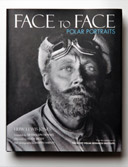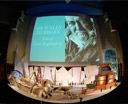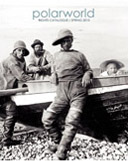 Our ProductsOur Resources |
This website requires the free Flash plugin to be installed.
Polarworld - discover more polar booksThe Arctic Book Review
Joanna Kavenna Reviewed by Peter Fjågesund The Ice Museum (recently republished by Penguin) has been hailed as an almost sensational debut, and when Viking launched the first edition in 2005, they brought out some big guns to grace the cover. Colin Thurbon called it "a truly original début" and a "sensitive exploration"; Giles Foden was "captivated"; having produced a stream of superlatives, Avi Shlaim concluded by praising Kavenna for her "profound knowledge of Nordic history, literature and mythology. The result is a magical book about a magical land." Finally, Robert Macfarlane called it "a brilliant debut, an important and unusual book". I have to admit I am not particularly enthusiastic about the practice among publishers of taking away from reviewers the chance of freely assessing a new and as yet unreviewed book by including on the cover what can only be called quasi-reviews, i.e. brief comments commisioned by the publisher in order to sell the book. In this case there is also something slightly worrying about the choice of names, because what are, for instance, Thubron's, Foden's and Shlaim's qualifications when it comes to Arctic and Nordic history? There are many aspects of The Ice Museum that I really liked, and it is undoubtedly a good read, but I also have some very important reservations about the book. First of all, as an academic I am both fascinated by and highly sceptical of the form. The genre of travel writing has always been double-edged. Since the Romantic period it has been a highly personal and subjective account. At the same time, many travel accounts are also impressively informative and reveal an admirable amount of reading and learning in a form that is accessible to the general reader. This successful combination of the subjective and the objective is very much present in books such as Barry Lopez' Arctic Dreams and Robert Macfarlane's Mountains of the Mind, and in a book that was published at the same time as Kavenna's: Robert McGhee's The Last Imaginary Place (recently reviewed here). Kavenna clearly uses these and others as recipe books for her own account. As it says on the jacket, she blends "travelogue, reportage, memoir and literary essay". From an academic point of view, the main problem is that the writer (and/or the publisher) offers no bibliography, footnotes or other references to sources. All it contains in the acknowledgements at the back are the names of a few persons and institutions that have offered her help and inspiration along the way. This means that Kavenna herself carries the whole burden of presenting a trustworthy account, while all the factual, or supposedly factual, information floats in mid air. As a result, a reader who finds some factual mistakes, immediately also begins to distrust other information. Kavenna, in other words, leaves herself open to the possibly unjust suspicion that much of the information presented is taken from unreliable sources or is simply invented. Sadly, a closer reading confirms that this suspicion is not unfounded. Let me give some examples: Kavenna claims, apparently as a fact, that Fridtjof Nansen "had even been offered the title of King after independence" (p.166; all page references are to the first edition). This rumour, however, is very loosely founded and should definitely not be referred to as a fact. Similarly, it is claimed that the Nazis offered Nansen "the title Übermensch, but Nansen refused it" (167). Again, as Nansen died in 1930, it would be interesting to see the source of this information. Also, there are no indications that Nansen visited Svalbard on his return from the Fram expedition in 1896 (309). Later on, the author describes a stay in a cabin near Bergen in the middle of the summer, and complains that "some nights we couldn't sleep at all, because the sun shone through the night hours" (174). Again, this gives the impression of something close to the midnight sun, which is definitely not found as far south as Bergen! Furthermore, at the age of eighteen, the author went on a trip from Bergen and northwards, and drove through "fishing villages and oil towns" (175). I am not aware that there are any oil towns north of Bergen. Neither is it true that the Germans destroyed Bodø at the end of the war, while retreating from the Russians (183-84). On the contrary, the German bombing took place at the very beginning of the war, in 1940, and the Russians were never at any time anywhere near as far south as Bodø. Finally, Svalbard was not "bombed and occupied by the Germans" during the war (311). Against this background, it becomes almost embarrassingly apt that the author claims on p. 196 that the writer Knut Hamsun after the war was "judged to have 'permanently impaired mental facilities'", clearly meaning "faculties". These factual mistakes leave serious doubts not just about the quality of the author's own research for the book and about the editorial work of the publisher, but also about the qualifications of the enthusiastic supporters on the book's cover. Again, with what authority does Avi Shlaim claim that Kavenna has a "profound knowledge of Nordic history" when he himself has not spotted such rather obvious slips? What is more serious than a frustrating number of factual mistakes, however, is the pervasively stereotyped attitude at the back of the entire narrative. From the point of view of non-British readers, this becomes a constant source of irritation. In the otherwise interesting chapter about the Thule Society in Germany, for instance, Kavenna describes the scene in a bar in Munich: "The Bavarians were sitting around tables, while the hostess slammed glasses of beer into their hands. Silence was verboten; everyone screamed and cheered, laughter came in basso waves across the room. The tables were engulfed in noise, a sense of community so pronounced it seemed like collective madness" (139). In light of the sinister story about the Nazi fascination with the land of Thule, which the author is in Munich to research, this passage confirms with a highly unpleasant use of irony some very primitive stereotypes about Germans in general. In the description of her journey through Norway, other stereotypes – uncritically inherited from nineteenth-century travel accounts – are equally conspicuous. While the author is staying near Trondheim in the winter, for instance, "it was impossible to walk for more than an hour in the cold air; it made my lungs ache …" (181). Similarly in Karasjok in Finnmark everyone in a supermarket "was buying hats and gloves, because the wind was growing harsher and more persistent by the hour" (213), as if people in this part of the world would run to the supermarket every time the cold set in! In other words, these incidents are either completely invented or drastically exaggerated. Another stereotype is that of Norwegian simplicity, primitivism and remoteness. Whereas Kavenna describes Bodø as "a small Arctic outpost" (183), a new webpage describes it like this: "With its 43,000 residents it is the second largest town in Northern Norway, with excellent communications and fully modern facilities. … Each year, more than 1.5 million people travel to and from Bodø by air, railway, bus, express boat or coastal steamer". A similarly stereotyped attitude, recognizable from numerous reality shows on TV, is found in the description of Kavenna's trip to the Thule air base in northern Greenland. In order to bring some needed drama into the voyage in a supposedly half-wrecked icebreaker, a conflict is introduced between the Captain (himself a stereotype of the rough Arctic captain) and a Phillipine sailor as to whether it is advisable to go that far north. The intention is clear: the author wants to introduce the old fear, present in numerous accounts from the Arctic, of being beset in the ice. The Captain, therefore, suddenly has qualms and adds, out of the blue, that permission to make a stop at the Thule base has been denied. In addition, we are asked to believe that Kavenna herself overhears this conversation while taking a nap on the deck (a few pages earlier the cold in Trondheim was too much for her lungs!). All in all, the incident is a classic fictional one (there is a parallel scene in Conrad's Heart of Darkness), and hardly credible as a realistic account. The next incident is hardly more credible. Having arrived in the bitterly cold Thule, she observes the drunken locals. One of them is an Inuit man standing on the shore, playing a guitar and singing "to the twilight". It is tempting to quote the entire paragraph: "He was singing about the mountian by old Thule, where the Inuit had buried their dead. It was a lament, soft in the stillness. As he played the locals began to sing along, a strange chorus, lifting their voices to the ice plain. A steady droning of male and female voices, with a few more Inuit coming to join the choir, huddled in their coats. It had a curious effect on my frozen senses – the soprano female voices, the men singing the bass lines, everyone shivering slightly on the beach, the lights of the town glinting up the rubble coast. It was crazy and moving, this faint sound of voices, in this village in the wilderness" (290). I am sorry, but to this reader, this account carries no conviction. On the contrary, it is contrived, artificial, made up, and only serves to reinforce old prejudices and preconceptions about simple and primitive peoples. Unfortunately, these weaknesses – and there are more than those mentioned here – tend to overshadow the book's qualities. It is to be hoped that author and publisher alike will take the opportunity, in connection with future editions, to make the changes that are needed. But it will require a major rewriting. As it stands, this book definitely does not deserve the praise that has been heaped upon it. One might dislike the rigour and complexities of real scholarship, but in this case a solid dose of it is required to balance the picture and create the kind of book that the topic deserves. |
|
||
follow us  | join us | join us  | home | contact | home | contact
|
||||
|
© Copyright Polarworld Ltd
SiteWizard.co.uk Web Site Design Company |
||||



 The Ice Museum: In Search of the Lost Land of Thule
The Ice Museum: In Search of the Lost Land of Thule